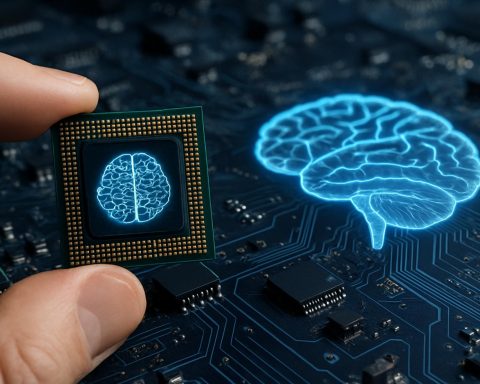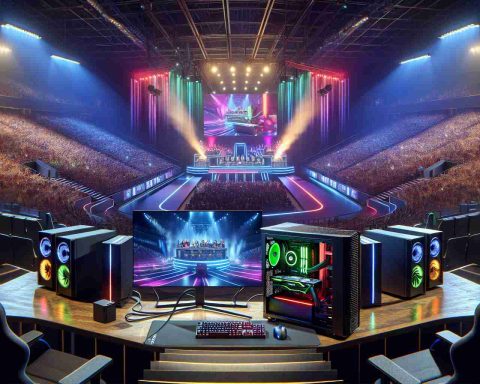- Nvidia’s DGX Spark and DGX Station redefine AI computing with revolutionary personal AI supercomputers.
- Powered by Grace Blackwell Superchips, DGX systems promise unmatched AI processing power and efficiency.
- DGX Spark operates at 1,000 trillion operations per second, equipped for demanding tasks.
- DGX Station features the GB300 Superchip and 784GB memory, enhancing connectivity up to 800Gb/s.
- Major manufacturers like Asus, Dell, HP, and Lenovo set to distribute these systems, with partnerships from BOXX, Lambda, and Supermicro.
- Reservations for DGX Spark available now, DGX Station’s release expected end of 2025.
- Pricing is hinted to start around $3,000, making AI supercomputers accessible to a broader audience.
- DGX systems herald a new era for developers and researchers, bridging AI models from local to cloud seamlessly.
Amidst the buzz of groundbreaking technology revelations, Nvidia’s latest unveiling at their GTX keynote promises to redefine personal computing. CEO Jensen Huang captivated onlookers with the introduction of two “personal AI supercomputers,” aptly named DGX Spark and the formidable DGX Station, breathing life into a vision molded by the cutting-edge Grace Blackwell platform. These aren’t merely upgrades but an entirely new approach to how we engage with AI, crafting bespoke architectures for a fresh generation of AI-centric endeavors.
Imagine a world where your desktop serves as a bustling hub of neural network activity, a laboratory unmatched by conventional setups. This dream becomes reality with the DGX systems, birthed from the visionary “Project DIGITS” previously teased earlier this year. For developers, researchers, and data scientists, these machines are not just tools but bridges—gateways to moving massive AI models from local environments to expansive cloud infrastructures with remarkable ease.
Huang, in a scene reminiscent of orchestrating a symphony, painted a vivid picture of this technological transition. AI has become the warp and weft of the computing tapestry, heralding the dawn of machines tailored for AI-native creators and their applications. This is not an evolution; it is a revolution at the heart of how we compute.
A glance under the hood reveals the /DGX Spark/, equipped with its GB10 Grace Blackwell Superchip, humming at a dazzling 1,000 trillion operations per second, while able to handle some of the most demanding AI tasks thrown at it. Yet, the true spectacle is the DGX Station, an architectural marvel boasting the GB300 Grace Blackwell Ultra Desktop Superchip paired with a staggering 784GB of coherent memory. It promises connectivity nirvana with its ConnectX-8 SuperNIC, soaring to networking speeds of up to 800Gb/s, setting new standards for AI processing power and efficiency.
The world watches as manufacturing giants Asus, Dell, HP, and Lenovo prepare to carve their mark on this AI landscape by selling these DGX systems. Even more intriguing is the roll call of partners like BOXX, Lambda, and Supermicro, adding their distinctive flavors to the DGX Station, readying for launch imminently. Reservations for the DGX Spark begin today, with the DGX Station following with anticipated public availability towards the end of 2025.
While Nvidia remains tight-lipped about exact pricing, echoes from earlier announcements suggest a starting point around $3,000 for the base configuration. It positions these supercomputers as accessible entrants into the once elusive world of AI, democratizing transformative technologies for the curious minds ready to shape the future.
In this epoch of AI, Nvidia’s DGX systems beckon—a call to the adventurous to explore, design, and innovate with the power of supercomputing at their fingertips.
Nvidia’s DGX Systems: Ushering in a New Era of AI Supercomputing
Introduction
In an era of rapid technological advancement, Nvidia’s introduction of the DGX Spark and DGX Station heralds a paradigm shift in personal AI computing. These innovations, powered by the revolutionary Grace Blackwell architecture, aim to reimagine how we harness AI, transitioning from traditional setups to AI-native environments. This comprehensive exploration unravels the potential these AI supercomputers hold and their implications for developers, researchers, and industries at large.
What Makes Nvidia’s DGX Systems Revolutionary?
1. Unprecedented Processing Power
The DGX Spark, with its GB10 Grace Blackwell Superchip, delivers a remarkable 1,000 trillion operations per second. This capability allows it to manage complex AI tasks efficiently, making it a potent tool for machine learning and data analysis projects.
The DGX Station takes it up a notch with the GB300 Grace Blackwell Ultra Desktop Superchip. Featuring 784GB of coherent memory and network speeds up to 800Gb/s through its ConnectX-8 SuperNIC, it offers unrivaled performance for handling vast datasets and complex neural networks.
2. Accessibility and Democratization
While Nvidia has not disclosed specific pricing, indications of a starting point around $3,000 suggest these systems are within reach for many organizations and individuals venturing into AI. Their accessibility promises to democratize AI technology, empowering more people to engage in groundbreaking research and innovation.
3. Ecosystem and Partnerships
Nvidia has partnered with notable manufacturers like Asus, Dell, HP, and Lenovo. Furthermore, collaborations with specialized entities like BOXX, Lambda, and Supermicro underscore Nvidia’s commitment to diversifying offerings and supporting varied industry needs.
Real-World Use Cases and Industry Trends
AI in Healthcare
The DGX systems can revolutionize healthcare by accelerating drug discovery, improving diagnostic processes with AI-enhanced imaging, and personalizing treatment plans through advanced data analysis.
Financial Sector
In finance, these supercomputers can optimize trading algorithms, manage risk more effectively, and enhance fraud detection systems, providing significant competitive advantages.
Autonomous Vehicles
The advanced processing capabilities of Nvidia’s DGX systems are crucial in developing and refining AI models for autonomous vehicles, enabling faster simulation, training, and deployment.
How To Transition to AI Computing with DGX Systems
1. Assess Needs: Evaluate the specific AI demands of your projects or organization to determine which DGX system suits your requirements.
2. Infrastructure Upgrade: Ensure your physical and network infrastructure can support the DGX systems’ high-performance demands.
3. Training and Development: Invest in training programs to equip your team with the necessary skills to fully leverage the DGX systems’ capabilities.
4. Iterative Implementation: Start with a pilot project to test the integration and progressively expand AI applications across your operations.
Pros and Cons Overview
Pros:
– Exceptional AI processing power
– Scalable for various industry applications
– Potentially cost-effective starting point
– Strong network of partners and support
Cons:
– High demand on infrastructure
– Initial investment in system upgrades and training
Insights and Predictions
As Nvidia’s DGX systems gain traction, expect accelerated innovation across sectors. With AI increasingly shaping industries, early adopters of these technologies will likely lead in developing cutting-edge solutions and securing strategic advantages.
Conclusion and Actionable Recommendations
To navigate this new frontier of AI supercomputing, businesses and individuals should embrace Nvidia’s DGX systems as a strategic investment in their future capabilities. Begin by evaluating your current capabilities, preparing your infrastructure, and strategizing a thoughtful implementation of AI-driven solutions.
For more insights and AI solutions, visit the Nvidia website.















